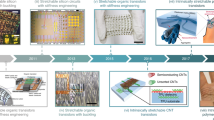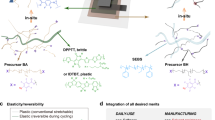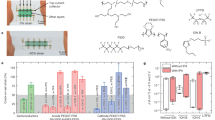Abstract
Intrinsically stretchable electronics with skin-like mechanical properties have been identified as a promising platform for emerging applications ranging from continuous physiological monitoring to real-time analysis of health conditions, to closed-loop delivery of autonomous medical treatment1,2,3,4,5,6,7. However, current technologies could only reach electrical performance at amorphous-silicon level (that is, charge-carrier mobility of about 1 cm2 V−1 s−1), low integration scale (for example, 54 transistors per circuit) and limited functionalities8,9,10,11. Here we report high-density, intrinsically stretchable transistors and integrated circuits with high driving ability, high operation speed and large-scale integration. They were enabled by a combination of innovations in materials, fabrication process design, device engineering and circuit design. Our intrinsically stretchable transistors exhibit an average field-effect mobility of more than 20 cm2 V−1 s−1 under 100% strain, a device density of 100,000 transistors per cm2, including interconnects and a high drive current of around 2 μA μm−1 at a supply voltage of 5 V. Notably, these achieved parameters are on par with state-of-the-art flexible transistors based on metal-oxide, carbon nanotube and polycrystalline silicon materials on plastic substrates12,13,14. Furthermore, we realize a large-scale integrated circuit with more than 1,000 transistors and a stage-switching frequency greater than 1 MHz, for the first time, to our knowledge, in intrinsically stretchable electronics. Moreover, we demonstrate a high-throughput braille recognition system that surpasses human skin sensing ability, enabled by an active-matrix tactile sensor array with a record-high density of 2,500 units per cm2, and a light-emitting diode display with a high refreshing speed of 60 Hz and excellent mechanical robustness. The above advancements in device performance have substantially enhanced the abilities of skin-like electronics.
This is a preview of subscription content, access via your institution
Access options
Access Nature and 54 other Nature Portfolio journals
Get Nature+, our best-value online-access subscription
$29.99 / 30 days
cancel any time
Subscribe to this journal
Receive 51 print issues and online access
$199.00 per year
only $3.90 per issue
Buy this article
- Purchase on Springer Link
- Instant access to full article PDF
Prices may be subject to local taxes which are calculated during checkout





Similar content being viewed by others
Data availability
Source data are provided with this paper.
References
Kim, D.-H. et al. Epidermal electronics. Science 333, 838–843 (2011).
Gao, W. et al. Fully integrated wearable sensor arrays for multiplexed in situ perspiration analysis. Nature 529, 509–514 (2016).
Son, D. et al. Multifunctional wearable devices for diagnosis and therapy of movement disorders. Nat. Nanotechnol. 9, 397–404 (2014).
Sim, K. et al. An epicardial bioelectronic patch made from soft rubbery materials and capable of spatiotemporal mapping of electrophysiological activity. Nat. Electron. 3, 775–784 (2020).
Dai, Y. et al. Stretchable transistors and functional circuits for human-integrated electronics. Nat. Electron. 4, 17–29 (2021).
Matsuhisa, N. et al. High-frequency and intrinsically stretchable polymer diodes. Nature 600, 246–252 (2021).
Jiang, Y. et al. Topological supramolecular network enabled high-conductivity, stretchable organic bioelectronics. Science 375, 1411–1417 (2022).
Xu, J. et al. Highly stretchable polymer semiconductor films through the nanoconfinement effect. Science 355, 59–64 (2017).
Wang, S. et al. Skin electronics from scalable fabrication of an intrinsically stretchable transistor array. Nature 555, 83–88 (2018).
Zheng, Y. et al. Monolithic optical microlithography of high-density elastic circuits. Science 373, 88–94 (2021).
Wang, W. et al. Neuromorphic sensorimotor loop embodied by monolithically integrated low-voltage, soft e-skin. Science 380, 735–742 (2023).
Tang, J. et al. Flexible CMOS integrated circuits based on carbon nanotubes with sub-10 ns stage delays. Nat. Electron. 1, 191–196 (2018).
Münzenrieder, N. et al. Flexible self-aligned double-gate IGZO TFT. IEEE Electron Device Lett. 35, 69–71 (2014).
Pecora, A. et al. Low-temperature polysilicon thin film transistors on polyimide substrates for electronics on plastic. Solid-State Electron. 52, 348–352 (2008).
Kang, S.-K. et al. Bioresorbable silicon electronic sensors for the brain. Nature 530, 71–76 (2016).
Chung, H. U. et al. Binodal, wireless epidermal electronic systems with in-sensor analytics for neonatal intensive care. Science 363, eaau0780 (2019).
Minev, I. R. et al. Electronic dura mater for long-term multimodal neural interfaces. Science 347, 159–163 (2015).
Capogrosso, M. et al. A brain–spine interface alleviating gait deficits after spinal cord injury in primates. Nature 539, 284–288 (2016).
Yu, X. et al. Skin-integrated wireless haptic interfaces for virtual and augmented reality. Nature 575, 473–479 (2019).
Kaltenbrunner, M. et al. An ultra-lightweight design for imperceptible plastic electronics. Nature 499, 458–463 (2013).
Park, S. et al. Self-powered ultra-flexible electronics via nano-grating-patterned organic photovoltaics. Nature 561, 516–521 (2018).
Won, P. et al. Stretchable and transparent kirigami conductor of nanowire percolation network for electronic skin applications. Nano Lett. 19, 6087–6096 (2019).
Kim, D. et al. Stretchable and foldable silicon integrated circuits. Science 320, 507–511 (2008).
Matsuhisa, N. et al. Printable elastic conductors with a high conductivity for electronic textile applications. Nat. Commun. 6, 7461 (2015).
Huang, Z. et al. Three-dimensional integrated stretchable electronics. Nat. Electron. 1, 473–480 (2018).
Sim, K. et al. Metal oxide semiconductor nanomembrane–based soft unnoticeable multifunctional electronics for wearable human-machine interfaces. Sci. Adv. 5, eaav9653 (2019).
Oh, J. Y. et al. Intrinsically stretchable and healable semiconducting polymer for organic transistors. Nature 539, 411–415 (2016).
Scott, J. I. et al. Significantly increasing the ductility of high performance polymer semiconductors through polymer blending. ACS Appl. Mater. Interfaces 8, 14037–14045 (2016).
Sim, K. et al. Fully rubbery integrated electronics from high effective mobility intrinsically stretchable semiconductors. Sci. Adv. 5, eaav5749 (2019).
Zheng, Y. et al. A molecular design approach towards elastic and multifunctional polymer electronics. Nat. Commun. 12, 5701 (2021).
Wang, W. et al. Strain-insensitive intrinsically stretchable transistors and circuits. Nat. Electron. 4, 143–150 (2021).
Singh, M., Haverinen, H. M., Dhagat, P. & Jabbour, G. E. Inkjet printing—process and its applications. Adv. Mater. 22, 673–685 (2010).
Liang, J. et al. Intrinsically stretchable and transparent thin-film transistors based on printable silver nanowires, carbon nanotubes and an elastomeric dielectric. Nat. Commun. 6, 7647 (2015).
Liu, J. et al. Fully stretchable active-matrix organic light-emitting electrochemical cell array. Nat. Commun. 11, 3362 (2020).
Borchert, J. W. et al. Flexible low-voltage high-frequency organic thin-film transistors. Sci. Adv. 6, eaaz5156 (2020).
Shirriff, K. The surprising story of the first microprocessors. IEEE Spectr. 53, 48–54 (2016).
Kim, M., Brown, D. K. & Brand, O. Nanofabrication for all-soft and high-density electronic devices based on liquid metal. Nat. Commun. 11, 1002 (2020).
Matsuno, R. et al. Relationship between the Relative Dielectric Constant and the Monomer Sequence of Acrylonitrile in Rubber. ACS Omega 5, 16255–16262 (2020).
Hoyle, C. E. et al. Thiol–enes: chemistry of the past with promise for the future. J. Polym. Sci. A Polym. Chem. 42, 5301–5338 (2004).
Cardenas, J. A., Andrews, J. B., Noyce, S. G. & Franklin, A. D. Carbon nanotube electronics for IoT sensors. Nano Futures 4, 012001 (2020).
Lei, T. et al. Low-voltage high-performance flexible digital and analog circuits based on ultrahigh-purity semiconducting carbon nanotubes. Nat. Commun. 10, 2161 (2019).
Fuhrer, M. S. et al. Crossed nanotube junctions. Science 288, 494–497 (2000).
Javey, A., Guo, J., Wang, Q., Lundstrom, M. & Dai, H. Ballistic carbon nanotube field-effect transistors. Nature 424, 654–657 (2003).
Zhu, C. et al. Stretchable temperature-sensing circuits with strain suppression based on carbon nanotube transistors. Nat. Electron. 1, 183–190 (2018).
Xu, J. et al. Multi-scale ordering in highly stretchable polymer semiconducting films. Nat. Mater. 18, 594–601 (2019).
Huang, T. C. et al. Pseudo-CMOS: a design style for low-cost and robust flexible electronics. IEEE Trans. Electron Dev. 58, 141–150 (2011).
Oh, H. et al. Scalable tactile sensor arrays on flexible substrates with high spatiotemporal resolution enabling slip and grip for closed-loop robotics. Sci. Adv. 6, eabd7795 (2020).
Jang, J. et al. Mechanoluminescent, air-dielectric MoS2 transistors as active-matrix pressure sensors for wide detection ranges from footsteps to cellular motions. Nano Lett. 20, 66–74 (2020).
Zhao, Z. et al. Large-scale integrated flexible tactile sensor array for sensitive smart robotic touch. ACS Nano 16, 16784–16795 (2022).
Park, M. et al. Si membrane based tactile sensor with active matrix circuitry for artificial skin applications. Appl. Phys. Lett. 106, 043502 (2015).
Acknowledgements
This work was partially supported by SAIT, Samsung Electronics, Army Research Office Bionic Electronics Program (grant no. W911NF-23-1-0282), CZ Biohub at San Francisco and Stanford Wearable Electronics Initiative (eWEAR). Part of this work was performed at the Stanford Nano Shared Facilities (SNSF), supported by the NSF award ECCS-2026822. We thank the Asahi Kasei Corporation for providing SEBS. We thank the Kraton Corporation for providing SBS. We thank Q. Liu, H. Yan, Y. Zheng, C. Zhu and Y. Jiang for their discussions.
Author information
Authors and Affiliations
Contributions
D.Z. and Z.B. conceived the project. D.Z. and Y.J. designed and developed the fabrication process. D.Z. and C.W. carried out the fabrication, measurement and demonstration. C.W., M.-g.K., Y.N., C.-C.S., W.W., Y.Y., N.M. and C.Z. provided inputs on the fabrication processes. D.Z., C.W., Y.N., W.W., Y.Y. and C.X. performed the electrical measurement. J.-C.L. measured the FT-IR spectrum. H.G. took the SEM images. Y.L. collected the UPS spectra. S.Z. performed the atomic force microscopy imaging. X.J., C.-C.S., Y.Z., Z.Y., D.L., J.-C.L. and Y.O. designed and synthesized the azide crosslinker and PFPD polymer. Y.-X.W. and Y.J. synthesized the polyrotaxane. T.Z.G., Y.N., C.-C.S. Y.Y. and D.Z. performed the CNT sorting. Y.Y., C.X., S.W. and S.L. helped with the demonstration. D.Z. carried out the modelling and simulation. D.Z., C.W., Y.J., J.B.-H.T. and Z.B. wrote the paper and incorporated the comments and edits from all authors.
Corresponding author
Ethics declarations
Competing interests
Stanford University is in the process of applying for a patent application 63/601,647 covering materials, device structure and fabrication process that lists Z.B., D.Z., C.W. and Y. J. as inventors.
Peer review
Peer review information
Nature thanks Michael Dickey and the other, anonymous, reviewer(s) for their contribution to the peer review of this work.
Additional information
Publisher’s note Springer Nature remains neutral with regard to jurisdictional claims in published maps and institutional affiliations.
Extended data figures and tables
Extended Data Fig. 1 Patterning of M-CNT electrodes using metal-assisted lift off method.
a, Schematic diagram showing the process of making PMMA/metal stack structures. Cu was used for the metal layer because of its low cost and wide use in the industry manufacturing of commercial electronics. The thicknesses of PMMA, metal and photoresist are about 400 nm, 150 nm and 1.2 μm, respectively. b, Optical microscope image of the fabricated PMMA/Cu stack structures with different gap sizes. The channel length will be defined by the gap size and the minimal gap can be smaller than 1 μm. c, Optical microscope image of M-CNT electrodes with different channel lengths. d, Photo showing the lift-off procedure for patterning M-CNT electrodes. M-CNT on the metal is removed cleanly from the substrate together with the metal, when PMMA film underneath is dissolved in acetone.
Extended Data Fig. 2 Patterning of PEDOT:PSS/PR gate electrodes.
a, Schematic diagram showing the process of patterning of PEDOT:PSS gate electrodes. b-d, OM images of fabrication steps. e, OM image of PEDOT:PSS gate etching test structure. f, Current flow between two electrodes before and after PEDOT:PSS etching. g, OM image of structure for PEDOT:PSS conductivity measurement. h, Conductivity of PEDOT:PSS before and after HNO3 treatment.
Extended Data Fig. 3 Patterning of EGaIn electrodes.
a, Schematic diagram showing the process of patterning EGaIn. Printed EGaIn via blade coating using PDMS will form an alloy with the Cr/Au adhesion layer to make a stretchable conductor. b-c, Optical microscope images of photoresist on soft substrates using normal development process (b) and quasi-static development process (c). d-e, Optical microscope images of EGaIn lines w/o sonication (d) and w/ sonication (e). Ultrasonication is necessary to achieve small feature sizes. This method was adopted from a previous report (ref. S2) and modified for working on soft substrates. Because of the large modulus mismatch between the photoresist (GPa) and the soft substrate (MPa), the edges of photoresist can easily form fractures during the development and rinsing process. To solve this issue, we immersed the sample into the developer and DI water without any shaking, and then dried it by keeping the sample sitting vertical in air.
Extended Data Fig. 4 Photopatterning process of NBR dielectric.
a, Schematic diagram showing the process of patterning NBR dielectric. A reduction of peak intensity of the C-H stretching near 920 cm−1 from -C = C-H is an indicator of crosslinking of some of the vinyl groups. b, FT-IR spectrum of NBR-PETMP crosslinking reaction. The green shade marks the region for a zoom-in view on the right. c, OM image of the patterned NBR array. d, Thickness of NBR patterns versus exposure doses using different crosslinking approaches. Compared with the azide crosslinker (4 wt% vs NBR) that requires a 254 nm wavelength illumination and a high dose, PETMP (4 wt% vs NBR) based thiol crosslinker can induce NBR patterning using a 385 nm wavelength light source with a significantly reduced exposure dose. The error bars describe the standard error for three samples in each case.
Extended Data Fig. 5 Comparison of contact resistance w/ and w/o Pd interface layer.
a, Device structure of transistors w/o Pd. b, Device structure of transistors w/ Pd. c, Transfer curves of transistors with different channel length w/o Pd. Vds = −1.0 V. d, Transfer curves of transistors with different channel lengths w/ Pd. Vds = −1.0 V. e, Extraction of contact resistance of transistors w/o Pd. f, Extraction of contact resistance of transistors w/ Pd. Data from four transistors were averaged for each Lch.
Extended Data Fig. 6 Voltage transfer curves of small-size intrinsically stretchable Pseudo-CMOS inverters with forward and backward sweeps.
a, Optical microscope image of a Pseudo-D inverter. b, Circuit diagram of a Pseudo-D inverter. c, Optical microscope image of a Pseudo-E inverter. d, Circuit diagram of a Pseudo-E inverter. e, Representative voltage transfer curve of one out of three measured Pseudo-D inverters. f, Representative voltage transfer curve of one out of two measured Pseudo-E inverters. Both types of inverters show small hysteresis. The device area is about 0.03 mm2, only one-fifth of the published smallest intrinsic stretchable inverters10.
Extended Data Fig. 7 Size, orientation and location measurement using intrinsically stretchable active-matrix tactile sensor array.
(a) OM images (Top) and on-state current mapping (Bottom) of two rectangles with different sizes. (b) On-state current mapping of two triangles with different orientations. (c) On-state current mapping of three rectangles at different locations. To measure each pixel, the corresponding word line was set at −7 V, while other word lines were set at 1 V. Vds = −1 V.
Extended Data Fig. 8 Mechanical stability of intrinsically stretchable active-matrix tactile sensor array.
(a-b) Drain current of one pixel versus time during multiple pressing over 1000 times. The corresponding word line was set at −6 V, while other word lines were set at 1 V. Vds = −1 V. (c) Extracted average drain current versus pressing cycles. (d) On-state current mapping of a small rectangle shape (800×800 μm2) after over 1000cycles of pressing. To measure each pixel, the corresponding word line was set at −10 V, while other word lines were set at 1 V. Vds = −1 V.
Extended Data Fig. 9 Setup of LED display using intrinsically stretchable transistors.
(a) Schematic diagram of the display system. (b) Photography of the display system. Each LED is driven by a transistor, which is switched on and off by its gate voltage VCTL, i (i = 1, 2, …, 35). VCTL for the transistors is supplied by four 12-channel digital-to-analog converters (DACs). To monitor the total current under deformations, a transimpedance amplifier is used to convert the current into a voltage signal, which is further read out by an analog-to-digital converter (ADC). The system logic and timing are controlled by a microcontroller. MCU represents the microcontroller, and DACs represent the digital-to-analogy converters.
Extended Data Fig. 10 Drive a LED display using intrinsically stretchable transistors under strain.
(a) Measured on-state current and off-state current of a typical transistor during stretched, twisted, and relaxed. (b) Photographs of intrinsically stretchable transistor array under deformed/released and corresponding LED display images. The unchanged patterns/brightness of the LED display, while the transistors are being stretched, twisted, and relaxed, demonstrates the excellent mechanical robustness of the transistors.
Supplementary information
Supplementary Information
This file contains Supplementary Notes, Supplementary Figs. 1–65, Supplementary Tables 1–4, captions for Supplementary Videos 1–2 and Supplementary References.
Supplementary Video 1
Intrinsically stretchable transistors drive a display system showing different numbers, letters and symbols.
Supplementary Video 2
Intrinsically stretchable transistors drive a display system with a refreshing rate of 60 Hz.
Rights and permissions
Springer Nature or its licensor (e.g. a society or other partner) holds exclusive rights to this article under a publishing agreement with the author(s) or other rightsholder(s); author self-archiving of the accepted manuscript version of this article is solely governed by the terms of such publishing agreement and applicable law.
About this article
Cite this article
Zhong, D., Wu, C., Jiang, Y. et al. High-speed and large-scale intrinsically stretchable integrated circuits. Nature 627, 313–320 (2024). https://doi.org/10.1038/s41586-024-07096-7
Received:
Accepted:
Published:
Issue Date:
DOI: https://doi.org/10.1038/s41586-024-07096-7
This article is cited by
-
Tailoring materials, structures and fabrication processes for stretchable electronics
Nature Reviews Electrical Engineering (2024)
Comments
By submitting a comment you agree to abide by our Terms and Community Guidelines. If you find something abusive or that does not comply with our terms or guidelines please flag it as inappropriate.



